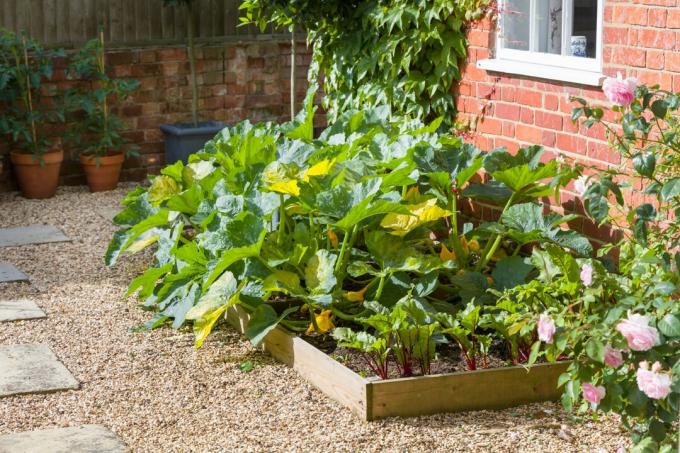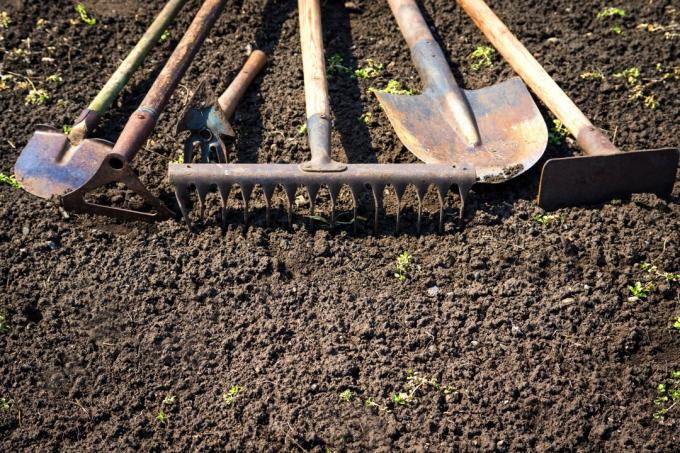Many would like to get fresh, healthy vegetables from their own garden. We'll tell you everything about the right location for a vegetable patch and guide you step by step to your own patch.

Creating a vegetable patch is not rocket science and even beginners can do it. However, there are a few points to consider regarding location and planning. With our article you will come a little closer to your goal of harvesting your home-grown vegetables soon.
contents
-
Creating a vegetable patch: the right location
- Create a vegetable patch on the slope
- Create a vegetable patch on the lawn
- When should you create a vegetable patch?
- Make a plan for the vegetable patch
- Step-by-step instructions
Creating a vegetable patch: the right location
When choosing the location of a new vegetable patch, you should pay particular attention to these aspects:
Sun and weather exposure
Most vegetables enjoy a sunny spot, which is why they should not be planted too close to large trees or shrubs. Furthermore, a sheltered, but not completely calm, place in the garden is particularly suitable. In this way, the plants are later protected from strong winds, but benefit from the air circulation. This enables faster drying in a lot of rain and thus offers fewer opportunities for fungal diseases to attack.
Soil quality
Another important aspect is the soil in which the vegetables will later grow. Ideally, it is loose and rich in humus, contains sufficient nutrients and does not tend to become waterlogged. Soil analysis can be done to determine which nutrients are already in your soil. Like you the present Determine soil type yourself, we explain in our article. In heavy, loamy soil, adding sand and compost improves the structure. If the earth is on the other hand rather sandy, it can be optimized with a little compost.
reachability
The last point that should be considered before creating the new bed is accessibility. You should consider placing the vegetable patch near the water connection, for example, in order to avoid long walks with heavy watering cans. The proximity to the compost heap can also be helpful so that garden waste does not have to be transported far when caring for the bed.

Create a vegetable patch on the slope
Not every garden is completely flat. Because of this, there is sometimes nothing left but to lay out the vegetable patch on a slope. The situation here is made more difficult by the fact that the water drains off quickly. So first a small level has to be created for the bed. You can build such a terrace with wooden palisades or natural stones, for example, so that the area can be filled with earth. The construction should also withstand heavy rain. In order to comfortably reach your new vegetable patch, a staircase will be necessary depending on the slope of the slope. Depending on the orientation of the slope, it is advisable to place the bed in the upper area. This is probably where most of the sun comes in. On the other hand, all the water often collects in the lower area of the slope, which threatens waterlogging.
Create a vegetable patch on the lawn
If you want to create your vegetable patch on a lawn, there are different approaches: The creation with digging or without digging, whereby the former means more work. A detailed guide to the Creating a bed without digging can be found in our corresponding article.
When creating with digging, the first step is to remove the sward about 10 to 15 cm deep. This works best with a spade. You can use this to mark the dimensions of the bed as a marker. A width of about 1.20 m is recommended here so that the middle of the bed can be reached later during maintenance and harvesting work.

Trenches
Trenching is a tried and tested method of digging up vegetable beds. Here, the bed area is again divided into smaller, approximately 60 cm wide strips. From the first piece, the sward and the soil dug deep into the spade are set aside. The sod of the next strip is turned over, shredded and placed in the previously excavated part. This will be replenished with the excavated earth from the second sector. This cycle repeats itself up to the last bed part, which is then filled with the turf and the earth of the first strip.
After the soil has been repaired, you should wait about two weeks before sowing and planting so that the soil can settle. It can take about one to two years for the sods to completely rot. During this time, particularly deep-rooted vegetables should be avoided or they should be digged even deeper when planting.
Anyone who owns equipment such as a tiller or a tiller at home can save a lot of work when creating beds. Otherwise, it could be worthwhile to borrow a corresponding device for a day, for example from a horticultural association.
When should you create a vegetable patch?
When the vegetable patch should be laid out depends on the seasons. The best time to do this is in autumn or spring. Both have their advantages and disadvantages.
If the bed is dug up in autumn, for example, compact chunks of earth from the surface are broken down by frost into fine-crumbly soil. However, the bottom organisms that came up through the digging are also not protected from the frost.
Tip: After digging up in autumn, sowing freezing green manure is a good way to to protect the soil from erosion, at the same time loosen it up and with organic matter to enrich. In our article about Green manure in autumn you will find detailed information on this.
In spring, the bed can be dug up after the ground frost has ended. This protects the microorganisms and living things in the soil over the winter and prevents nutrients from being washed out. However, the cultivation schedule can be postponed a bit in the event of prolonged permafrost, as one has to wait. In addition, the work is likely to be more strenuous than in the fall - the earth is very wet and heavy at this time.

Make a plan for the vegetable patch
When planning the planting plan for the vegetable patch, it is essential to consider which vegetables you like to eat. In this step it is already determined what will be planted in the first place. The next step is to consider what quantities of the respective vegetables are needed in order to calculate the space requirements.
When planting, it is also important to pay attention to the nutritional requirements of the plants. There are heavy, medium and weak consumers who need different amounts of nutrients in the soil. Because of this, the so-called crop rotation can be adhered to, in which a different type of vegetable is planted in the same place every year. In a small vegetable patch, however, this method is not always useful or necessary. At the so-called Mixed culture you can orientate yourself better. The point here is that different plants have certain interactions with each other and have a corresponding positive or negative effect on the other vegetables. For example, should Carrots (Daucus carota) between Onions (Allium cepa) are planted, pests such as the onion fly (Delia antiqua) keep away.
When planning, you should also consider the cultivation periods of the different types of vegetables and coordinate them with one another in order to make the most sensible use of the space in the bed. A staggered harvest is also an option for vegetables with shorter cultivation times.

Step-by-step instructions
- Select location: sunny, sheltered from the wind, easily accessible
- Determine bed dimensions: Recommended width of 1.20 m
- Dig up the area in autumn or spring
- Improve the soil with suitable soil or compost
- Create a planting plan
- Sow and prefer plants
Which soil is suitable for creating a vegetable patch? The soil structure and the nutrient content of your vegetable patch can be improved with suitable soil. Our Plantura organic tomato & vegetable soil is particularly suitable, for example, for tomatoes (Solanum lycopersicum), Vegetables such as zucchini (Cucurbita pepo subsp. pepo convar. giromontiina) and chilli (Capsicum). The organic tomato and vegetable soil consists of 100% natural raw materials and does not contain peat. It ensures healthy plant growth and a rich harvest.
In addition to a vegetable patch, a small herb garden should not be missing. How do you feel in your own garden Create a herb bed, we explain to you in our special article.

